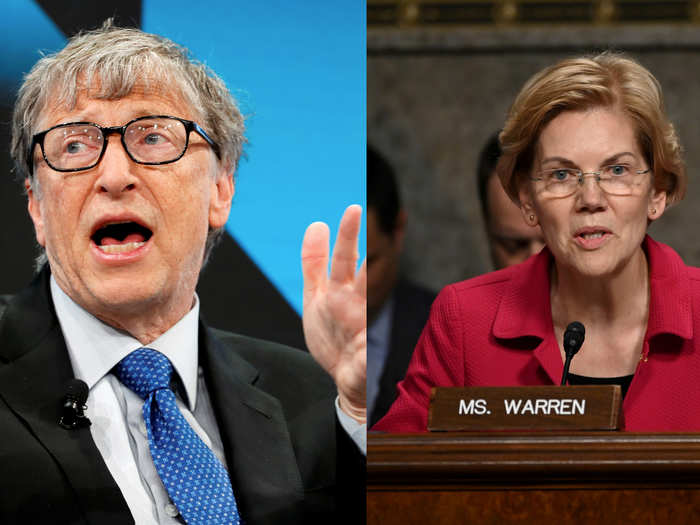
Warren wanted to redistribute capitalism's rewards to a larger share of the population.
Her plan would kick in at $50 million, with households paying a 2% annual tax on their assets like stocks, paintings, yachts, and homes. The tax would ramp up to 6% for households with fortunes over $1 billion.
The campaign projected it would raise $3.75 trillion over a decade, though other economists disputed the forecast. Warren planned to use the revenue generated to fund universal healthcare under Medicare for All and universal childcare among other priorities.
The proposal would have significantly slashed the fortunes of some of America's wealthiest people. For example, the 2018 net worth of Microsoft founder Bill Gates stood at $97 billion.
But if her tax plan had been implemented 36 years ago — or 1982, the first year Forbes started estimating wealth — Gates's fortune would stand at $13.3 billion, according to estimates from progressive economists Gabriel Zucman and Emmanuel Saez.

Warren was the first major presidential candidate to propose canceling a substantial portion of student debt in the US, unveiling the plan last year.
She called to make two-year and four-year colleges and universities free for people so they wouldn't be "paying a dime in tuition or fees." The proposal carried a price tag of $610 billion.
Her $640 billion loan forgiveness plan would have slashed up to $50,000 in debt for student loan borrowers making less than $100,000. It also sought to gradually forgive debt for people earning up to $250,000. Both proposals — totaling $1.25 billion — were paid for by the wealth tax.
Sanders followed up with a student debt plan of his own that wiped it out entirely by way of a new tax on Wall Street, escalating the policy duel between them.
Then in January, Warren put forward another plan laying out how she would achieve her student-loan objectives, mainly by empowering the Education Department and sidestepping Congress.
Federal data shows that the share of student debt has doubled over the past decade from $700 billion to $1.6 trillion, overtaking credit cards and car loans as the largest share of debt held by 45 million Americans. The average college student graduates with at least $30,000 in debt, CNBC reported.
A Quinnipiac poll last year found that 57% of Americans backed Warren's student loan policies.

Early last year, Warren rolled out a plan aimed at making childcare both affordable and easy to access for parents. She wanted to create a network of facilities to take care of children that the federal government subsidized and regulated.
"There are two big problems with child care in America: it's hard to find high-quality care, and where you do find it, that care is extraordinarily expensive," she wrote in the proposal, noting that care for one child could cost anywhere from 9% to 36% of a family's total income.
Child care would have been free to any family earning below 200% of the federal poverty line. For families over that threshold, the cost would be capped at 7% of their income.
The government currently provides some assistance for low-income families with children, and working parents can benefit from a child-care tax credit.
But half of Americans reside in communities with no licensed care provider for children or contend with a vast shortage of available slots, according to the Center for American Progress, which called these areas "child care deserts."
 Luxury “floating” beach unveiled in France, termed an “ecological aberration”
Luxury “floating” beach unveiled in France, termed an “ecological aberration”
 Scientists think they’ve spotted 60 potential alien power plants in the Milky Way!
Scientists think they’ve spotted 60 potential alien power plants in the Milky Way!
 Bread, butter, milk-based health drinks, cooking oils classified as ultra-processed food, ICMR advises restriction
Bread, butter, milk-based health drinks, cooking oils classified as ultra-processed food, ICMR advises restriction

Copyright © 2024. Times Internet Limited. All rights reserved.For reprint rights. Times Syndication Service.